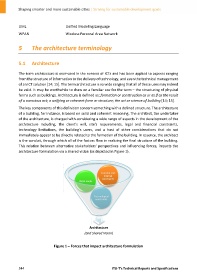Page 354 - Shaping smarter and more sustainable cities - Striving for sustainable development goals
P. 354
UML Unified Modeling Language
WPAN Wireless Personal Area Network
5 The architecture terminology
5.1 Architecture
The term architecture is over‐used in the context of ICTs and has been applied to aspects ranging
from the structure of information to the delivery of technology, and even the technical management
of an ICT solution [14; 15]. The term architecture is so wide ranging that all of these uses may indeed
be valid. It may be worthwhile to draw on a familiar use for the term – the structuring of physical
forms such as buildings. Architecture is defined as: formation or construction as or as if as the result
of a conscious act; a unifying or coherent form or structure; the art or science of building [14; 15].
The key components of this definition concern something with a defined structure. The architecture
of a building, for instance, is based on solid and coherent reasoning. The architect, the undertaker
of the architecture, is charged with considering a wide range of aspects in the development of the
architecture including, the client's will, site's requirements, legal and financial constraints,
technology limitations, the building's users, and a host of other considerations that do not
immediately appear to be directly related to the formation of the building. In essence, the architect
is the conduit, through which all of the factors flow in realizing the final structure of the building.
This relation between alternative stakeholders' perspectives and influencing forces, impacts the
architecture formulation via a shared vision (as depicted in Figure 1).
External and
Internal
constraints
Client needs
Technological
constraints
Architecture
(and Shared Vision)
Figure 1 – Forces that impact architecture formulation
344 ITU‐T's Technical Reports and Specifications

